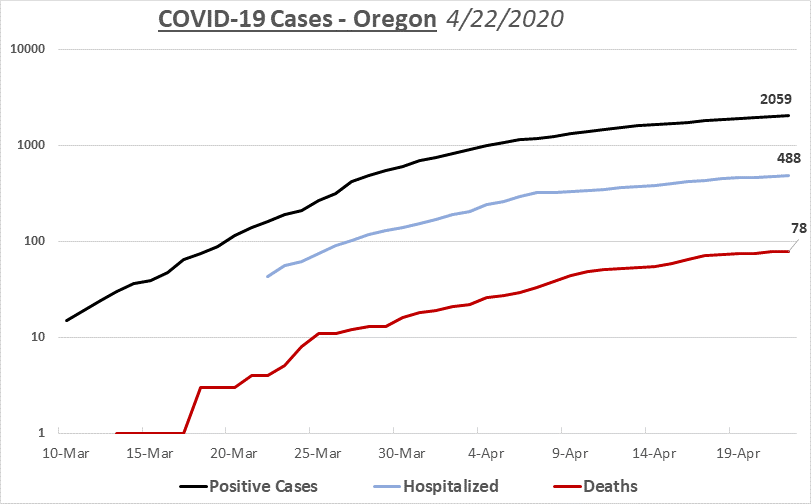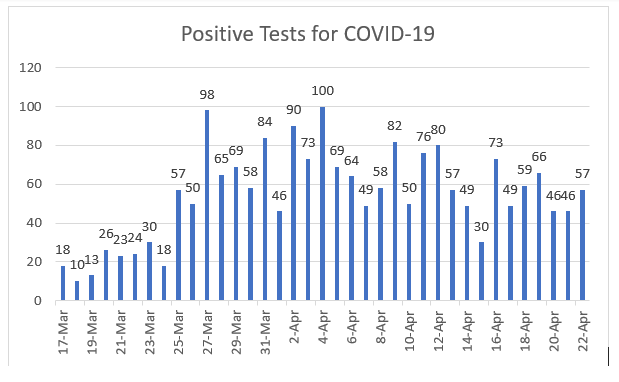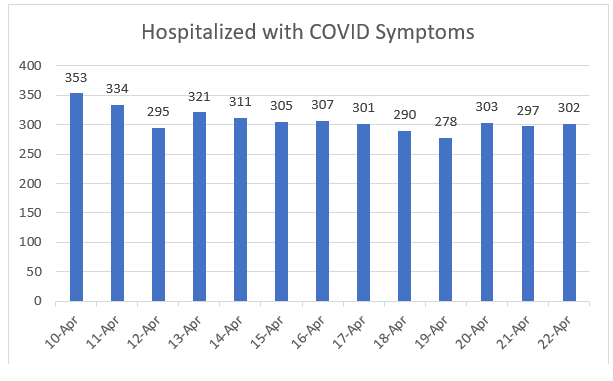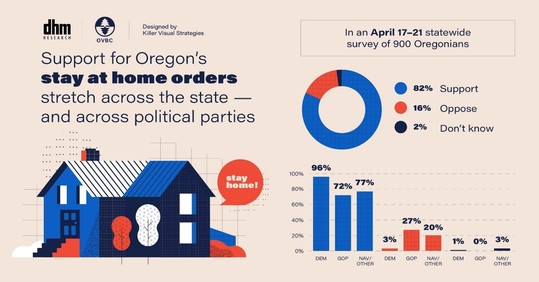|
April 22, 2020
Dear Neighbors and Friends:
I hope that you and your loved ones are doing well, staying healthy, and looking out for your neighbors and friends.
Lots to report on today. New Corona-related information and resources. Some additional information related to higher education and tomorrow’s meeting of the Legislature’s Emergency Board. Another reminder about tomorrow’s Happy Hour Zoom Town Hall.
Tomorrow we’re also expecting final passage of the new revisions to the federal CARES Act, which will bring additional much-needed resources to small businesses and hospitals. Here is a quick summary of its provisions. I’ll have more to say about it after it has passed. The Senate passed it yesterday, the House will do the same tomorrow, and we expect the President to sign it right away. Additional dollars could be going out as soon as Friday. Fingers crossed that the funds get to the people and places that really need them.
TODAY’S CORONAVIRUS AND CORONAVIRUS RESPONSE UPDATE

***Please notice that I’m now using an exponential scale for the Y axis on this graph. Doing it this way allows for a more realistic sense of the upward curves of these three data points (positive cases, hospitalizations, and deaths).
-
Positive Cases: OHA has reported that 57 additional Oregonians tested positive for COVID-19 yesterday, putting the total at 2,059.
-
Total Tests: We’re still awaiting the reporting of total tests for today.
-
Ratio: On hold until we learn the total number of tests. I can say that the national % of positive tests has gone down around 1% to 18.5%, largely as a result of a big increase in new tests across the country yesterday.
-
Deaths: I’m happy to report that NO new deaths were reported yesterday, so the total number of deaths in Oregon remains at 78.
-
Hospitalized: The number of Oregonians who have been hospitalized with symptoms, and who have also tested positive for the disease, is now at 488 This is an increase of 17 from yesterday.
-
Other Hospital Information:
- Available ICU Beds: 336 (a decrease of 10 from yesterday)
- Other Available Beds: 2,195 (a decrease of 16 from yesterday)
- Patients Currently w COVID-19 Symptoms (who may or may not have received a positive test result yet): 302 (an increase of 5 from yesterday). Of those, 124 have already received a positive test back.
- ICU Patients w COVID-19 Symptoms (who may or may not have received a positive test result yet): 67 (3 fewer than yesterday)
- COVID-19 Patients Currently on Ventilators: 35 (the same as yesterday).
- Available Ventilators: 788 (4 more than yesterday)
-
Today’s National Numbers:
-
PPE:
- The Emergency Coordination received 180,000 pairs of gloves in the last 24 hours.
-
Other State Updates:
- The Portland Housing Bureau has just announced that it will allocate $1 million of its budget for direct cash grants to individuals needing help with housing payments as a result of the pandemic. Funds will become available on April 27. For information about the program and how to apply, here's the link.
- OHA has completed 101 preemptive guidance consultations of Long-Term Care Facilities (LTCF) regarding infection prevention so far.
- OHA and the Department of Human Services will be testing all staff and residents of the Foster Creek facility, where a number of cases and deaths have been reported. As long as testing equipment continues to be available, OHA and DHS intend to test all employees and residents of long-term care facilities where one or more cases of COVID-19 have been identified.
- Happy to say that DHS reports that no children in foster care or in group homes have tested positive for COVID to date.
- Not so happy to say that DHS reports a 400% increase in new applications for SNAP (i.e., food stamps).
- The Oregon Youth Authority, which oversees state juvenile corrections, reports that so far all outstanding COVID-19 tests of youth in facilities have come back negative. Part of the strategy for keeping youth safe is temporarily minimizing contact with people from the outside. Specific dorms have been converted into quarantine areas to separate new arrivals for 14 days prior to introduction to the existing youth population.
Legislature’s Emergency Board Meets Thursday Morning
I’ve mentioned that the Legislature’s Emergency Board will be meeting tomorrow morning at 10 a.m. to approve around $32 million in funding for response to the disease and the economic fallout. It is going to be a remote meeting, meaning that E-Board members will be conducting their business via videoconferencing. The Capitol remains closed during the coronavirus crisis, but a viewing station will be available outside on the front steps of the Capitol.
The meeting will be streamed live, and you can watch it at https://olis.oregonlegislature.gov/liz/2019I1/Committees/EB/2020-04-23-10-00/Agenda. Meeting materials have already been posted, and you can get to them at https://olis.leg.state.or.us/liz/2019I1/Committees/EB/2020-04-23-10-00/MeetingMaterials
Please let me know if you have any questions.
Joint Virtual Town Hall: Tomorrow!
I am again partnering with my house colleagues Barbara Smith Warner and Alissa Keny-Guyer for a virtual constituent event. This time around, we’ll be doing a “happy hour” at 5pm tomorrow (Thursday 4/23). As we did a few weeks ago, we’ll be using Zoom as the platform for this town hall. Click here to pre-register and submit questions and comments for us to address. I look forward to “seeing you” tomorrow evening and providing more updates on the state’s response to the COVID-19 pandemic. I expect we will have plenty to share in the wake of the morning’s E-Board meeting.
Weekly COVID Update from OHA
We’ve just received this week’s weekly update, which includes a couple of new and very useful features. Their reporting on racial/congregate populations has been refined and the number of “unknowns” is coming down. One of the new useful features is that they are displaying cases in numbers per 10,000 of that population, so you can get a real sense of the way that the disease is disproportionately hitting different groups (e.g., Hispanics and Pacific Islanders). You’ll also see a list of the long-term care facilities that are being hit hard by the virus. And we’ll also be getting updates on how people are recovering from the illness. Regarding recovery, here’s what the report has to say:
Recovery
Oregon is assessing recovery of COVID-19 cases by calling each case to determine if they have recovered and the date of recovery. A person is considered recovered once they are free of fever (without the use of fever-reducing medication), cough, and shortness of breath for 72 hours. If they are not yet recovered, public health staff will call back weekly until the person is recovered. COVID-19 cases without symptoms are considered recovered 7 days after the last positive test. Of the 1,853 surviving COVID-19 cases, 595 (32.1%) are considered recovered and 682 (36.9%) are not yet recovered. We are still assessing recovery status for 576 (31.1%) of the COVID-19 cases. The median time to recovery for all cases who had symptoms is 14 days (interquartile range:10–20 days). The median time to recovery for cases who were hospitalized and had symptoms is 16 days (interquartile range: 11.5–24 days).
New Resource from the ECC
The Emergency Coordination Center has redone their website to make the information more interactive and easier to follow. I highly recommend it. Here are some of its features:
- Easy access to the Daily Covid-19 Data Report
- Resources – Extensive resources listed by topic
- PPE information – information on outgoing and incoming shipments, with a daily breakdown by county of PPE received
- Easy access for anyone wanting to donate, sell or volunteer services or goods
- Map –case data by county
- Do Your Part – An A-Z run down of information and public service announcements from the CDC
You can access the website here.
Two New Graphs to Help Track Oregon’s Cases
As the state begins to think about when we can start Phase One of the reopening process, two things we need to be looking at is the number of new infections reported each day and the number of individuals hospitalized with COVID symptoms each day. I’m going to start providing graphs for you to follow these two metrics. According to the OHA, we are in a “plateau” in terms of the epidemiology of the disease, and these graphs seem to support that conclusion.
Remember that the hospitalization numbers being used here are those currently in the hospital with symptoms, but who may or may not have received a positive test result yet.


Colleges/Universities Finally Receive Guidance on Use of CARES Act Funds: Support for Dreamers Prohibited
The U.S. Department of Education has issued the agency’s guidelines for colleges and universities on how they can use their CARES Act funding. This guidance has been long awaited by students and institutions wondering how they can access the dollars that were promised to them. (Here again is the list of allocations to Oregon's colleges and universities.) Roughly half of each institution’s allocation must go to direct support payments for students in need. The other half can go to help the institutions deal with the financial fallout of responding to the virus and closing their campuses.
The Department has put up a website with information about how the CARES Act affects higher education, with a more detailed explanation of the program’s direct allocations for students in an FAQ.
I was on a videoconference this afternoon with other legislative advisors to WICHE. (That’s the Western Interstate Compact on Higher Education; I’m a legislative representative from Oregon.) We received a briefing on the new CARES Act higher ed funding program. These new funds have the potential to be a real life-line for many students and institutions. However, we learned that colleges and universities are going to be very restricted in how they can do the direct support payments for students. Here are some of the things they CAN do:
- Give direct payments to students (by check or direct deposit) for expenses related to campus closures, including having to relocate and their future technology needs. These should go to students based on financial need.
- Continue to pay Federal Work-Study salaries even if the students are not on campus, and the federal government will pick up the full cost of that.
And here are some of the things colleges and universities CANNOT do:
- Reimburse the institution for any Corona-related support they gave students prior to the passage of the Act on March 27.
- That includes reimbursing the institution for the cost of computers or any other equipment they gave students.
- Use the money to pay off student account balances.
- Reimburse the institution for salaries paid to student workers or use it to continue to pay student workers other than those on Federal Work Study (though these students can still receive support payments if they are in need).
- Use any of the funding to support Dreamers, i.e., DACA recipients, those students who are U.S. residents but without documentation. If they are ineligible for federal financial aid, as DACA students are, they are ineligible for CARES Act support, both via the student support dollars and via the institutional support dollars.
This last exclusion, I would argue, is yet another crushing form of discrimination against these young people who have grown up in this country, attended our schools, know no other country, and have so much to offer. They need our support as much as other students do.
For now, if you’re able to, I know that most if not all of our colleges and universities have ways for you to donate to help these high-potential students get through this crisis and complete their studies. I’m proud to see that Portland Community College has already established a DREAMer support site in response to the Coronavirus crisis. I’m sure that other institutions have or will as well. I’ll be supporting them, and I hope you can too.
New Survey Shows How College/University Faculty Are Adjusting
As I’ve mentioned in previous newsletters, many college and university faculty have had to radically change their teaching styles and teaching materials in order to switch to an all-distance environment. Anecdotally, and from the outside, their hard work seems to be paying off. But how do they feel about these changes? Inside Higher Education, an online news service for everything Higher Ed, reported this morning on a just-released survey of 826 faculty members and administrators at 641 colleges and universities across the country. The results are interesting. You can read about them here.
Speaking of Surveys:

***You can get the details on this survey here.
Want to See Past Newsletters?
If there was COVID-related information in a past newsletter that you want to go back to, but find you’ve deleted it, you can always go to my legislative website (www.senatordembrow.com), click on “News and Information,” and you’ll find them all there.
AND FINALLY,
Here again are some resources that you will find useful:
If the above links are not providing you with answers to your questions or directing you to the help that you need, please consider me and my office to be a resource. We’ll do our best to assist you or steer you in the right direction.
Best,
 Senator Michael Dembrow
District 23
email: Sen.MichaelDembrow@oregonlegislature.gov
web: www.senatordembrow.com
phone: 503-986-1723
mail: 900 Court St NE, S-407, Salem, OR, 97301
|